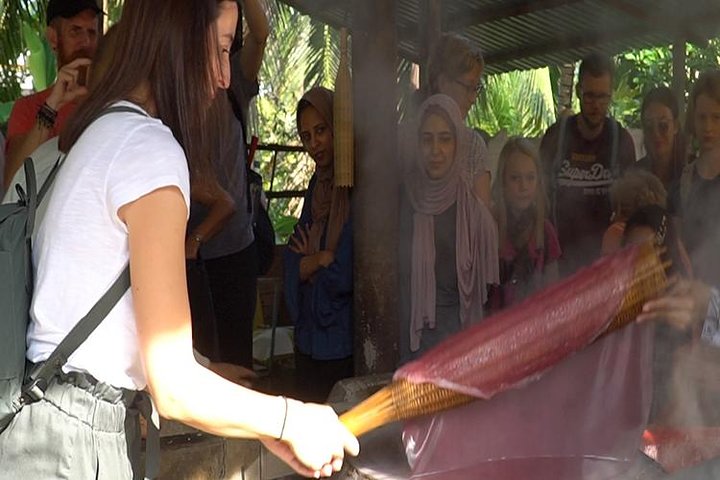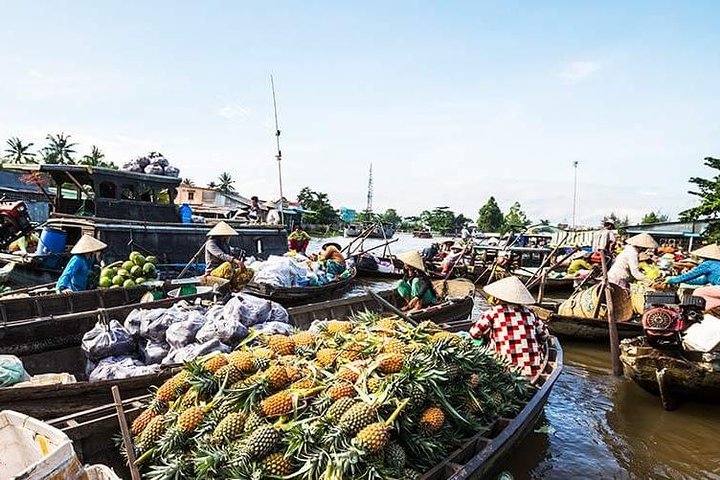- Phu My Port Vietnam - Starting operations 20 years ago in the south of Vietnam, Baria Serece – Phu My Port is being recognized for its high standards in safety, with fast, effective and reliable port services available to the customers 24 hours per day round year. They are strategically located on the Thi Vai River basin, making Baria Serece Phu My Port a great inbound gateway for the cargo that will be distributed within Vietnam, and, also giving to our customers a possibility to outbound cargo thru Asia and world.
Phu My Port is located on Cai Mep-Thi Vai linking-port Road, Phu My District-level Town, Tan Thanh District, Ba Ria Vung Tau Province. Phu My Port is about 40 km from Vung Tau City, 70 km from the center of Saigon, 110 km from Cu Chi Tunnels, 125 km from, Mekong Delta. It takes about 1 hour to Vung Tau City, about 1.5 hours to Ho Chi Minh City, and about 2 hours and 45 minutes to reach My Tho – Mekong Delta from Phu My Port by road way.
You’ll be picked up at main gate of Phu My port to Saigon
-
The Independence Palace - Surrounded by royal palm trees, the dissonant 1960s architecture of this landmark government building and the eerie ambience of its deserted halls make it an intriguing spectacle. The first Communist tanks to arrive in Saigon rumbled here on 30 April 1975 and it’s as if time has stood still since then. The building is deeply associated with the fall of the city in 1975, yet it’s the kitsch detailing and period motifs that steal the show. It’s also known as the Independence Palace.
The building was named Independence Palace and was home to the succeeding South Vietnamese president, Nguyen Van Thieu, until his hasty departure in 1975. Designed by Paris-trained Vietnamese architect Ngo Viet Thu, it is an outstanding example of 1960s architecture, with an airy and open atmosphere.
The Reunification Palace, also known as Independence Palace, is a landmark building located in the heart of Ho Chi Minh City. And it is known as a must see National Monument once you are in Ho Chi Minh City. - Central Post Office - The city’s landmark French-era post office is a period classic, designed by Marie-Alfred Foulhoux (though often credited to Gustave Eiffel) and built between 1886 and 1891. A mosaic of Ho Chi Minh takes pride of place at the end of its barrel-vaulted hall.
The post office features a unique, bright yellow exterior framed with white trim. Curved windows are elegantly framed with green shutters and a large clock is featured prominently at the building’s main entrance. The stunning, spacious interior has tall, domed ceilings with metal arches and a gorgeous patterned tile floor. There are two painted maps inside the office – Lignes télégraphiques du Sud Vietnamet du Cambodge 1892 (Telegraphic lines of southern Vietnam and Cambodia 1892) depicts the postal route from southern Vietnam to Cambodia, and on the right side of the building is Saigon et ses environs, 1892 (Saigon and its surroundings), a local map.
- War Remnants Museum - Founded on September 4, 1975, The War Remnants Museum is a member of the International Network of Museums for Peace (INMP) and the International Council of Museums (ICOM).
It is the unique museum in Vietnam to systematically study, collect, conserve and display exhibits on war crimes and consequences inflicted on the Vietnamese people by foreign aggressive forces. Simultaneously, the Museum appeals to everybody to oppose unjust wars, preserve global peace, promote friendship and solidarity among nations.
The Museum is endowed with 9 permanent thematic exhibitions and various special collections. All year round, a wide range of activities are organized, including conferences, meetings with war witnesses, temporary and itinerant exhibitions. With nearly one million domestic and international visitors per year, The War Remnants Museum is one of Ho Chi Minh City’s most enticing cultural and tourist sites.
-
Khách sạn Bông Sen Sài Gòn - First introduced in Vietnam over a decade ago in 1998, Ganh Bong Sen Buffet offers the perfect balance between the traditional dishes of Vietnamese cuisine and the Western-styled buffet.
A hand-painted features in the mural are images of many popular dishes normally found at the corners of open marketplaces in provincial towns, such as banh canh, banh xeo, banh khot, bun rieu, bun mam, to name a few.
At the Ganh Bong Sen Buffet, the creative, talented, and experienced chefs elevate these common traditional dishes into symbols of culinary excellence with a taste that is both distinctive and yet equally familiar to a connoisseur of Vietnamese delicacies.
It is no surprise that many come to Ganh Bong Sen Buffet in order to enjoy the characteristic flavors of the three regions. You want to experience the culture of Vietnam. You want to be satisfied. Well, you can count on us. Here at Ganh Bong Sen Buffet, every meal is a feast for the gods.
- Sơn mài Đại Việt - The lacquer itself is actually the resin of a tree which is mixed with coloured pigments and solvents and applied layer after layer to the object’s surface, producing a shiny and durable finish. Eggshell and mother of pearl may be applied to the surface before the lacquer is applied, in which the finished product is sanded down to reveal the decoration beneath.
The high quality of resin from Vietnamese lacquer trees, notably those of Phu Tho, was a crucial factor in the rapid development of this art form during the feudal period.
Decorated lacquer statues, panels, boxes and trays (1428-1527), may still be seen at many temples and pagodas.
In subsequent centuries the use of lacquerware was extended to larger items such as wooden chairs and tables.
Since that time lacquerware has continued to develop into one of the mainstays of the Vietnamese handicraft industry, both at home and abroad. Today’s most popular items include vases, jewel cases, desk sets, trays and vertical blinds.
- Emperor Jade Pagoda - Built in 1909 in honour of the supreme Jade Emperor (King of Heaven), this is one of the most atmospheric temples in Ho Chi Minh City, stuffed with statues of phantasmal divinities and grotesque heroes.
The pungent smoke of incense fills the air, obscuring the exquisite woodcarvings. Its roof is encrusted with elaborate tile work, and the temple’s statues, depicting characters from both Buddhist and Taoist lore, are made from reinforced papier mâché.
The multifaith nature of the temple is echoed in the shrine’s alternative name Phuoc Hai Tu, whose message is clearly Buddhist. Similarly, the Chinese character in the main temple hall mean ‘The light of Buddha shines on all.
Over 100 years old went by with many changes, Jade Emperor Pagoda remains the timeless charm. Its beauty is a harmonious combination among 3 main religions in the Orient: Taoism, Buddha, and Confucianism.
Thanks to the impressive & unique beauty with sacred legend, this is one of the most wonderful destinations.
- Phu My Port Vietnam - Starting operations 20 years ago in the south of Vietnam, Baria Serece – Phu My Port is being recognized for its high standards in safety, with fast, effective and reliable port services available to the customers 24 hours per day round year. They are strategically located on the Thi Vai River basin, making Baria Serece Phu My Port a great inbound gateway for the cargo that will be distributed within Vietnam, and, also giving to our customers a possibility to outbound cargo thru Asia and world.
Phu My Port is located on Cai Mep - Thi Vai linking - port Road, Phu My District-level Town, Tan Thanh District, Ba Ria Vung Tau Province. Phu My Port is about 40 km from Vung Tau City, 70 km from the center of Saigon, 110 km from Cu Chi Tunnels, 125 km from, Mekong Delta. It takes about 1 hour to Vung Tau City, about 1.5 hours to Ho Chi Minh City, and about 2 hours and 45 minutes to Mekong Delta from Phu My Port by road way.
You’ll be dropped off at main gate of Phu My port from Saigon.

- Traditional Buffet Lunch & Bottled water
- All entrance fees
- Air-conditioned vehicle
- Picking up & dropping off at Phu My Port
- English speaking tour guide
- Tipping/ gratuities, personal expenses
Ho Chi Minh City, also known as Saigon and long considered as the Pearl of the Far East, is the most dizzying city of commerce and culture in Vietnam. A visit to Saigon is like an encounter with exotic delicious food, French colonial architecture and memories of Vietnam War.
A state-run handicraft enterprise exports a wide range of products—including furniture, carpets, lacquer paintings, and other works of art—made largely from local materials and you will be shown a part of this attraction. Ganh Buffet is well known as one of most typical traditional Vietnamese cuisines with diversified famous foods such as Banh Xeo…
There are so many amazing attractions and you will have a chance to discover apart of those such as War Remnants Museum to learn more about Vietnam War, Jade Emperor Pagoda to learn more about a part of Vietnamese culture. Saigon Central Post Office is known as Center of Telegraph in Indochina War or exploration the National Monument of Reunification Palace
- The remaining hours are allotted for the travel time
- Travel time is already included in the total duration of the tour
- Everyone can join this tour
For a full refund, cancel at least 24 hours before the scheduled departure time.


































